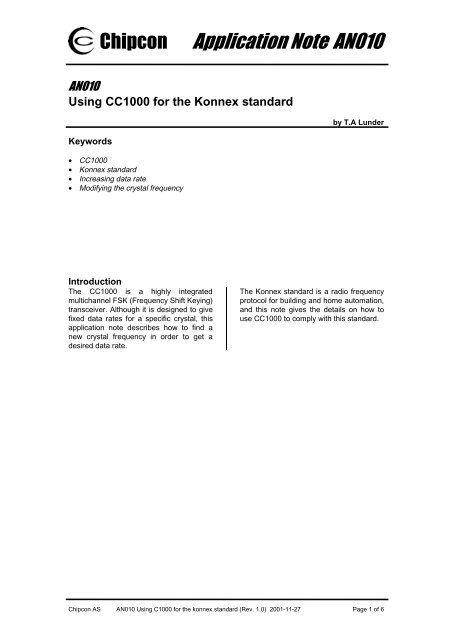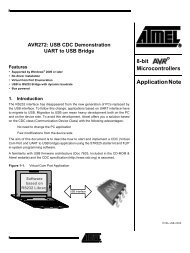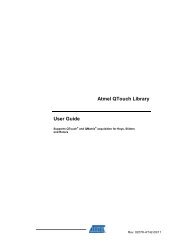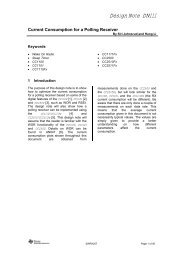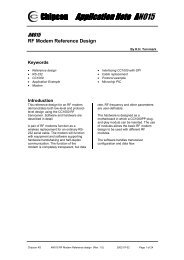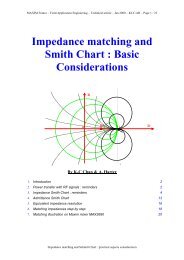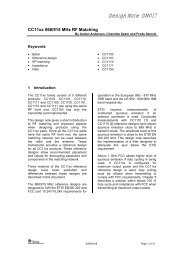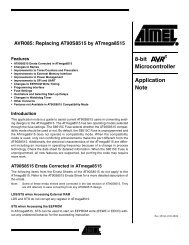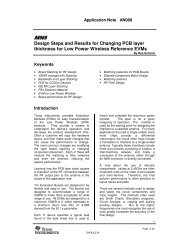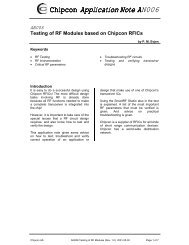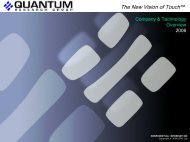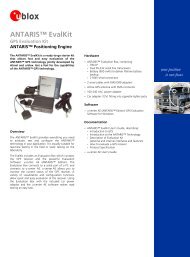Using CC1000 for the Konnex standard
Using CC1000 for the Konnex standard
Using CC1000 for the Konnex standard
Create successful ePaper yourself
Turn your PDF publications into a flip-book with our unique Google optimized e-Paper software.
&KLSFRQ$SSOLFDWLRQ1RWH $1$1<strong>Using</strong> <strong>CC1000</strong> <strong>for</strong> <strong>the</strong> <strong>Konnex</strong> <strong>standard</strong>Keywords• <strong>CC1000</strong>• <strong>Konnex</strong> <strong>standard</strong>• Increasing data rate• Modifying <strong>the</strong> crystal frequencyby T.A LunderIntroductionThe <strong>CC1000</strong> is a highly integratedmultichannel FSK (Frequency Shift Keying)transceiver. Although it is designed to givefixed data rates <strong>for</strong> a specific crystal, thisapplication note describes how to find anew crystal frequency in order to get adesired data rate.The <strong>Konnex</strong> <strong>standard</strong> is a radio frequencyprotocol <strong>for</strong> building and home automation,and this note gives <strong>the</strong> details on how touse <strong>CC1000</strong> to comply with this <strong>standard</strong>.Chipcon AS AN010 <strong>Using</strong> C1000 <strong>for</strong> <strong>the</strong> konnex <strong>standard</strong> (Rev. 1.0) 2001-11-27 Page 1 of 6
&KLSFRQ$SSOLFDWLRQ1RWH $1The konnex <strong>standard</strong>The RF parameters <strong>for</strong> <strong>the</strong> konnex <strong>standard</strong> are given in <strong>the</strong> table bellow.Parameter Value Unit NoteRF frequency 868.3 MHzFreq tolerance +/- 25 ppmFSK deviation +/- 50 kHz Min +/- 40, max +/- 80 kHzCodingManchesterChiprate 32768 Kchip/s = kBaud Specify crystal frequencyData rate 16384 kbit/s Same as 16 kHz square waveChip rate tolerance 1.5 % Also related to crystal frequencyTX jitter +/- 1 usOutput power 0 dBm MinimumBlocking EN300220, class 2RX chip rate +/- 2 %toleranceRX sensitivity -95 dBm BER=10-4Preamble 15xchips 01Signal interface and crystal frequencyThe <strong>CC1000</strong> offers a synchronous signal interface. That is, in transmit mode <strong>the</strong> <strong>CC1000</strong>provides a clock (DCLK) according to <strong>the</strong> selected data rate. The data input (DIO) should belatched using this clock. In receive mode <strong>the</strong> <strong>CC1000</strong> provides a clock that is synchronouswith <strong>the</strong> incoming data rate toge<strong>the</strong>r with <strong>the</strong> data output (DIO).To be able to use <strong>the</strong> synchronous mode <strong>for</strong> <strong>the</strong> <strong>Konnex</strong> <strong>standard</strong>, we need <strong>CC1000</strong> togenerate a synchronisation signal on <strong>the</strong> DCLK <strong>for</strong> <strong>the</strong> given data rate. The frequencydiscriminator, data filtering and <strong>the</strong> data slicer are all handled by digital signal processing andare controlled by <strong>the</strong> MODEM0 register. The register in<strong>for</strong>mation of MODEM0 is given below.REGISTER NAME DescriptionMODEM0[7] - Not usedMODEM0[6:4] BAUDRATE[2:0] 000 : 0.6 kbaud001 : 1.2 kbaud010 : 2.4 kbaud011 : 4.8 kbaud100 : 9.6 kbaud101 : 19.2kbaud110 : Not used111 : Not usedMODEM0[3:2] DATA_FORMAT[1:0] 00 : NRZ operation.01 : Manchester operation10 : Transparent Asyncronous UART operation11 : Not usedMODEM0[1:0] XOSC_FREQ[1:0] Selection of XTAL frequency range00 : 3MHz - 4MHz crystal, 3.6864MHz recommended01 : 6MHz - 8MHz crystal, 7.3728MHz recommended10 : 9MHz - 12MHz crystal, 11.0592 MHz recommended11 : 12MHz - 16MHz crystal, 14.7456MHz recommendedChipcon AS AN010 <strong>Using</strong> C1000 <strong>for</strong> <strong>the</strong> konnex <strong>standard</strong> (Rev. 1.0) 2001-11-27 Page 2 of 6
&KLSFRQ$SSOLFDWLRQ1RWH $1To be able to generate <strong>the</strong> baud rates given by BAUDRATE[2:0] we need to use <strong>the</strong>recommended crystal frequency. For <strong>the</strong> <strong>Konnex</strong> however we want to use a baud rate of32.768 kbaud. To generate a data rate higher than specified with <strong>the</strong> recommended crystalfrequency, it is possible to program XOSC:FREQ corresponding to a crystal frequency that ishalf of <strong>the</strong> actually crystal frequency. In this case <strong>the</strong> demodulator is “fooled” to work at twice<strong>the</strong> speed and thus twice <strong>the</strong> data rate. We must <strong>for</strong> <strong>the</strong> <strong>Konnex</strong> case find a crystal frequencygiving a baud rate of 16.384 kbaud, and <strong>the</strong>n reduce <strong>the</strong> XOSC_FREQ[1:0] to correspond to acrystal frequency that is half <strong>the</strong> one we are using.The easiest way to find <strong>the</strong> crystal frequency <strong>for</strong> a given data rate is to use <strong>the</strong> <strong>for</strong>mula:XTAL _ new =XTAL _ SRFS * BAUDRATE _ newBAUDRATE _ SRFShereXTAL_SRFS: The recommended values <strong>for</strong> accurate data rates (3.6864, 7.3728,11.0592, 14.7456 MHz).BAUDRATE_SRFS: The accurate data rate <strong>for</strong> <strong>the</strong> given XTAL_SRFS (0.6, 1.2, 2.4, 4.8,9.6 19.2 kbaud).The MODEM0 value <strong>for</strong> <strong>the</strong> new data rate can <strong>the</strong>n be calculated in SmartRF Studio (SRFS)by <strong>the</strong> XTAL_SRFS and BAUDRATE_SRFS.If we use:XTAL_SRFS = 7.3728 MHzBAUDRATE_SRFS=19.2 kbaudBAUDRATE_NEW=32.768 kHz (<strong>Konnex</strong>)Then(7.3728MHz) *(32.768kbaud)XTAL _ new == 12. 582912MHz19.2kbaudGiving a baud rate of 32.768 kbaud.This crystal frequency gives an accurate baud rate that complies with <strong>the</strong> <strong>Konnex</strong> <strong>standard</strong>.However using this crystal frequency, <strong>the</strong> frequency <strong>for</strong> optimal sensitivity will have an offset infrequency of 229.1 kHz from 868.3 MHz. This crystal frequency can not be used if optimalsensitivity is required. If optimal sensitivity is required, <strong>the</strong>n <strong>the</strong> crystal frequency value mustbe changed so that both <strong>the</strong> optimal frequency and <strong>the</strong> data rate complies with <strong>the</strong> <strong>Konnex</strong><strong>standard</strong>. Changing <strong>the</strong> crystal frequency to 12.586060 MHz gives an offset of 11.9 kHz and adata rate of 32.778 kbaud. A summery of <strong>the</strong> crystal frequency is given in <strong>the</strong> table below.Crystalfrequency[MHz]Data rate[kbaud]Channelfrequency [MHz]Offset from 868.3 MHz[kHz]12.582912 32.768 868.3 0 No12.586060 32.778 868.2881 11.9 Yes**Spreadsheet <strong>for</strong> finding closest optimal channels is available from Chipcon.OptimalsensitivityBy using <strong>the</strong> same approach as above, but in asynchronous mode (UART) <strong>the</strong> data rate canalso be increased to rates not being multiples of <strong>the</strong> <strong>standard</strong> data rates (i.e. 1.2, 2.4, 4.8 kbit/sChipcon AS AN010 <strong>Using</strong> C1000 <strong>for</strong> <strong>the</strong> konnex <strong>standard</strong> (Rev. 1.0) 2001-11-27 Page 3 of 6
&KLSFRQ$SSOLFDWLRQ1RWH $1and so on). In this mode <strong>the</strong> data clock (DCLK) is not used, so <strong>the</strong> over-sampling and <strong>the</strong>synchronisation must be done externally, by a microcontroller, or by an UART.The <strong>Konnex</strong> protocolA preheader that has a Manchester Violation is used in <strong>the</strong> konnex <strong>standard</strong>. TheSynchronous Manchester mode can <strong>for</strong> this reason not be used in <strong>the</strong> TX mode of <strong>CC1000</strong>during transmission of this Preheader.In Rx mode <strong>the</strong> settling of <strong>the</strong> averaging filter in <strong>CC1000</strong> require a balanced baud in <strong>the</strong>preamble. In Manchester mode <strong>the</strong> chip stream must be ’100110011001…’ during <strong>the</strong>preamble to ensure correct bit synchronisation. The <strong>Konnex</strong> preamble is however a chipstream of ‘0101010101’.PreheaderPreamble Manchester Sync word Postambleviolation15x ‘01’ chip ‘000111’ ‘011010010110’ 2-8 chipsDue to <strong>the</strong> <strong>Konnex</strong> preheader, <strong>CC1000</strong> must use Synchronous NRZ mode and not useSynchronous Manchester mode. The Manchester coding must <strong>the</strong>n be done in <strong>the</strong> MCU and<strong>the</strong> datarate of this Manchester coded data need a datarate of 32.768 kbaud. <strong>Using</strong> <strong>the</strong>synchronous NRZ mode, <strong>the</strong> preamble of balanced baud are ‘01010101..’, because <strong>the</strong> baudrate is <strong>the</strong> same as <strong>the</strong> bit rate in NRZ. Fur<strong>the</strong>r <strong>the</strong> Manchester violation bit stream can easilybe implemented.In NRZ mode <strong>the</strong> settling time should be set to 01 to give a settling time of <strong>the</strong> averaging filterin <strong>the</strong> demodulator to 32 baud. In NRZ <strong>the</strong> baud rate is equal to <strong>the</strong> bit rate, and <strong>the</strong> <strong>Konnex</strong>require that <strong>the</strong> receiver are able to receive valid data after <strong>the</strong> preamble. This preamble is 30baud in NRZ mode, and it is ok <strong>for</strong> <strong>the</strong> <strong>CC1000</strong> to use SETTLING=01 in MODEM1 Register.<strong>CC1000</strong> Rx test <strong>for</strong> <strong>Konnex</strong>A preliminary test was per<strong>for</strong>med using <strong>the</strong> calculated crystal frequency, in order to verify thatRX mode complies with <strong>the</strong> <strong>Konnex</strong> <strong>standard</strong>. During <strong>the</strong> test, a Signal Generator was used togive <strong>the</strong> Crystal frequency. The test result is given in <strong>the</strong> table below.Crystal SeparationMODEM0SensitivityfrequencyBAUDRATE DATA_FORMAT XOSC_FREQ12.586060 80 kHz 101 00 NRZ 01 -96 dBm12.586060 100 kHz 101 00 NRZ 01 -97 dBm12.586060 160 kHz 101 00 NRZ 01 -96 dBmTx data rate offset of 2% gives no effect on <strong>the</strong> sensitivity.Chipcon AS AN010 <strong>Using</strong> C1000 <strong>for</strong> <strong>the</strong> konnex <strong>standard</strong> (Rev. 1.0) 2001-11-27 Page 4 of 6
&KLSFRQ$SSOLFDWLRQ1RWH $1The blocking per<strong>for</strong>mance of <strong>CC1000</strong> is given in <strong>the</strong> table below.Frequency offset <strong>CC1000</strong> Requirement+/- 1 MHz 43 dB 30 dB+/- 2 MHz 49 dB 35 dB+/- 5 MHz 68 dB 50 dB+/- 10 MHz 72 dB 60 dBThe blocking result between +/- 10 MHz offset of 868 MHz is given in figure 1. This indicatesthat <strong>CC1000</strong> complies with <strong>the</strong> blocking requirement of <strong>the</strong> <strong>Konnex</strong> <strong>standard</strong>.80706050dBc403020100855 860 865 870 875 880-10Figure 1: Blocking per<strong>for</strong>mance of <strong>CC1000</strong> at 868 MHz<strong>CC1000</strong> Tx test <strong>for</strong> <strong>Konnex</strong>The synchronous data clock in transmit mode will also be scaled as shown above. The loopfilter bandwidth is adequate <strong>for</strong> baud rate at 32.768 kbaud but an optimisation of <strong>the</strong> PLLbandwidth could be done to improve <strong>the</strong> modulation response. A simple modulation analysiswas per<strong>for</strong>med, and <strong>the</strong> time versus frequency plot showed a peak-to-peak separation of +/-120 kHz using a programmed frequency separation of 100 kHz. The <strong>Konnex</strong> require aseparation between 80-160 kHz, and <strong>CC1000</strong> complies with <strong>the</strong> <strong>Konnex</strong> regarding modulation.In transmit mode <strong>the</strong> DCLK gives a signal equal to <strong>the</strong> data rate, and has no duty cycle offset.This in<strong>for</strong>ms us that <strong>the</strong>re is no TX jitter on <strong>the</strong> transmitted signal.SummaryBy using a crystal frequency of 12.586060 MHz with a total accuracy of 11.5 ppm, <strong>the</strong> datarate and <strong>the</strong> frequency tolerance of <strong>the</strong> <strong>Konnex</strong> <strong>standard</strong> can be met. The sensitivity is –96dBm also meeting <strong>the</strong> <strong>standard</strong>.Chipcon AS AN010 <strong>Using</strong> C1000 <strong>for</strong> <strong>the</strong> konnex <strong>standard</strong> (Rev. 1.0) 2001-11-27 Page 5 of 6
&KLSFRQ$SSOLFDWLRQ1RWH $1This application note is written by <strong>the</strong> staff of Chipcon to <strong>the</strong> courtesy of our customers.Chipcon is a world-wide supplier of RFICs. For fur<strong>the</strong>r in<strong>for</strong>mation on <strong>the</strong> products fromChipcon please contact us or visit our web site. An updated list of distributors is also availableat our web site.Contact In<strong>for</strong>mationAddress:Chipcon ASGaustadalléen 21N-0349 Oslo,NORWAYTelephone : (+47) 22 95 85 44Fax : (+47) 22 95 85 46E-mail : wireless@chipcon.comWeb site : http://www.chipcon.comDisclaimerChipcon AS believes <strong>the</strong> furnished in<strong>for</strong>mation is correct and accurate at <strong>the</strong> time of this printing. However, ChipconAS reserves <strong>the</strong> right to make changes to this application note without notice. Chipcon AS does not assume anyresponsibility <strong>for</strong> <strong>the</strong> use of <strong>the</strong> described in<strong>for</strong>mation. Please refer to Chipcon’s web site <strong>for</strong> <strong>the</strong> latest update.Chipcon AS AN010 <strong>Using</strong> C1000 <strong>for</strong> <strong>the</strong> konnex <strong>standard</strong> (Rev. 1.0) 2001-11-27 Page 6 of 6


